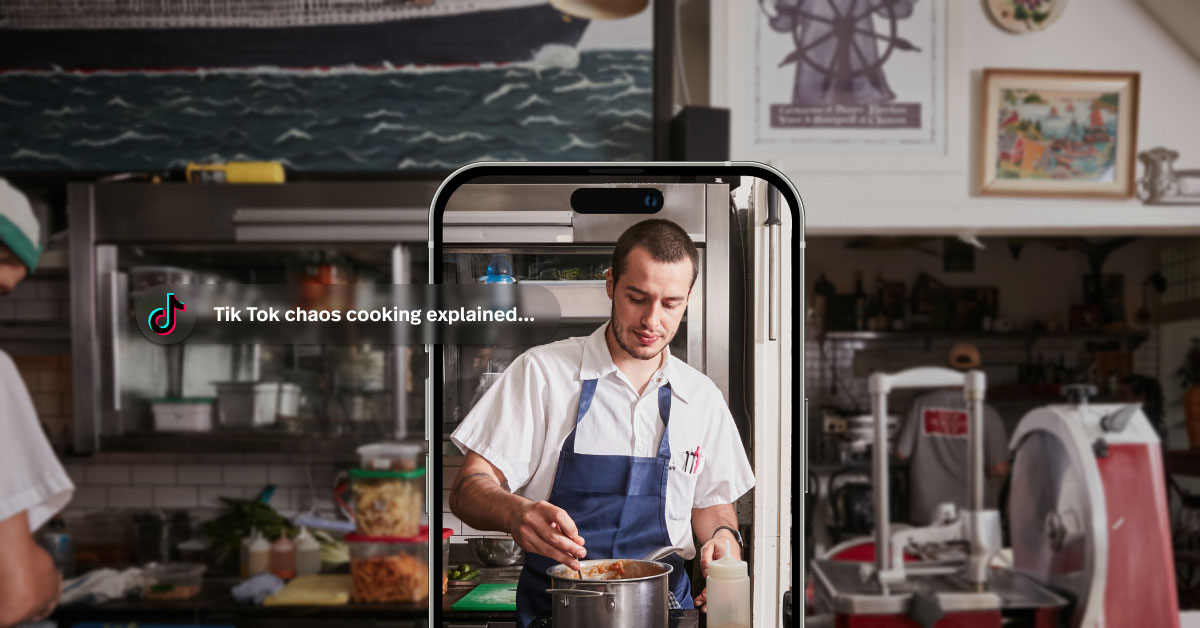
We’ve all been there. You’re at a restaurant, your food has arrived at the table. You’re ravenous and ready to eat.
But wait.
Your dining partner needs a minute to take the now-compulsory photos of their food. And yours too, for some reason. To deny them would be almost cruel. To even think about eating your food without compiling an album of poorly-lit evidence that it did indeed exist would be tantamount to heresy!
I am not one of the photo-taking people. It is a trend that I would pay to see go away and never darken our dining rooms again.
Thankfully, my dream may become a reality, and it’s all because of the new favourite social media app of foodies the world over: TikTok.
TikTok, with its video-based content and an algorithm designed for users to stumble upon content rather than find themselves bombarded with irrelevant posts, is slowly changing the dining landscape as operators look to capitalise on the latest food trends contained within.
But what are these food trends, you ask?
Let’s dig in.
- Why is this happening?
- Value in experience
- What is chaos cooking?
- The tinned fish glow up
- Using the past to profit in the present
- TikTok is king, for now
Why is this happening?
This is a fair question.
Previously, popular apps like Instagram and Facebook ruled the roost and while posting video content was an option, it never really outshone the might of a static image.
The more savvy restaurateurs realised early on that the prettier a dish looked, the better traction it would get online and the more people would learn about their venue, so restaurants around the world began to compete for who could make the most-photogenic dish imaginable. For the first time in forever an important factor most kitchens considered when creating dishes was not about how the food tasted, but how it looked.
This saw a rise in things designed to boost the aesthetics and catch the eye on your feed. Things like towering stunt burgers, brazen in their decadence, all the way down to delicate edible flowers, meaningfully placed atop some smashed avo. Precision plating had spread beyond its traditional confines of fine dining and had cooks of all levels reaching for the tweezers.
With the rise in popularity of TikTok however, static images are falling out of favour. Content consumers want videos and that medium lends itself to a very different type of food content altogether.
The emphasis has shifted away from the superficial and is barrelling towards valuing the process in all of its authentic glory!
In short, pretty photos of food are out and rough-looking cooks filming themselves actually creating the dishes from scratch in their home kitchen is in. Let’s have a look at some of these trends, shall we?
Let’s have a look at some of these trends, shall we?
Value in experience
There is what I consider a dark side to TikTok influencing our dining trends. A new, updated version of the perfect, heavily-staged food photos of Instagram feeds past. It’s that they still kind of exist, except this time, they move!
Think of it as a transition. We were unable to give up our pictures of food (excuse the pun) cold turkey, so we needed something aligned, something adjacent to wean us away from the static and towards motion.
Where once were fanned avocado slices, now there’s a slow motion cheese pull. Where there were deliberately-laid micro herbs, there is a ball of burrata being pierced. For each towering, melty mess of multi-pattied, how-are-you-meant-to-eat-that burger, there’s now somebody wearing black latex gloves squeezing the life out of a perfectly-smoked brisket.
I blame Salt Bae.
It’s tableside pageantry on levels not seen since Escoffier was on the tools which means we might be stuck with a chef who wears sunglasses indoors at night whilst sprinkling salt onto $500 steaks for a little while longer.
And it goes beyond teppanyaki restaurants or a tableside plating of cacio e pepe from a wheel of Parmigiano Reggiano.
From the classic preparation of a Caesar Salad at the table (featuring our favourite: tinned anchovies, no less), to flambé desserts, the tableside plating is experiencing a renaissance.
But we humans tend to take things too far, and I fear we have fallen prey to this impulse again. There are ways to keep things respectable (let’s hear it for the classic Raclette), because too far is a surefire way to rub the average diner the wrong way.
It’s no longer enough for a chef to prepare a meal in a professional kitchen. Put simply, this is a rise in valuing the experience as much as the food.
What is chaos cooking?
Now, you’re probably thinking the same thing I was when I first heard the term ‘chaos cooking’. Cooking can already be pretty chaotic, right? Am I about to be dragged into some PTSD-laden short form video that’s going to force me to relive nightmare shifts of the past?
Thankfully, this is not what it means.
Chaos cooking is basically what we called fusion in the 90s but with (somehow) less thought about whether it should be created in the first place, just like the dinosaurs in Jurassic Park. Do we really need tandoori chicken spaghetti? I mean, probably, right?
The main difference between traditional fusion (and the reason that chaos cooking has taken off) is that fusion cooking always seemed a bit forced, a bit too planned. Chaos cooking on the other hand is extremely freeing. The whole idea is about taking the flavours, ingredients, delivery methods and techniques that you already love and throwing them all against each other to create something new.
It’s 90s fusion cooking with the training wheels taken off and I’m here for every single serve of savoury cannoli (shoutout The Bear), donner kebab al pastor tacos and whichever cuisine our creative cooks can squeeze into a sandwich.
The tinned fish glow up
Oddly specific trend, I know, but it is a trend nonetheless and here’s why: it all stems from turning snacks into meals. That’s right, similar to the wine night mainstay, the charcuterie board, snacks have evolved into full meals and even made their way onto many a respected menu in the restaurant world.
But why have tinned fish, of all things, leapt above all else?
Have you ever delved into the world of tinned fish? What appears to be a fairly narrow pool of opportunity on the surface quickly reveals itself to be a vast ocean of appealing qualities.
Let’s start with the branding. It is, in my opinion, gorgeous. Each tin seems to have been blessed by an artist whose considerable talents and good tastes are surely wasted on something as arbitrary as food packaging.
The colours, the fonts, the illustrations, swirls and adornments! I’m yet to see a tin where I didn’t want to thoroughly clean it and take it home to put on my shelf so that I could look at it and feel that enveloping rush of dopamine every time I’m feeling a bit flat.  Even the cheaper options like Ortiz or Sirena seem to be leagues ahead of other tinned goods.
Even the cheaper options like Ortiz or Sirena seem to be leagues ahead of other tinned goods.
And there’s a certain prestige created by such packaging. It’s evocative of some glamourous, cosmopolitan-yet-secluded Mediterranean alcove, where Chanel-clad socialites pick at their sardines over martinis and anecdotes from last night’s gala.
Who would have thought that the unassuming tinned fish had the potential to make us feel like Grace Kelly?
The other reason they’re popular is because of their versatility.
They pack some serious flavour and are often tender to the point of melting, making them perfect additives to meals. Throw some anchovies into a sauté pan and watch them melt, imparting their salty, umami goodness into whatever hits the pan from there on out.
They also have an impressive shelf life, able to outlast most of the bric a brac in your pantry. And because it’s 2023, there’s even some plant-based options for tinned fish. Think of that what you will, but they exist.
Using the past to profit in the present
Have you ever wondered how McDonalds manages to get their burgers to taste so delicious? Have you ever tried to recreate the Macca’s magic at home? Did you fail miserably and end up with grease running down your forearm?
You’re not alone.
Recreating fast food items at home is a big deal on social media, with creators like Joshua Weissman and Binging With Babish going on to release best-selling cookbooks featuring recipes based on popular fast food items. Jordan The Stallion, self-proclaimed President of The Fast Food Secrets Club, has amassed an enormous following purely from filming recipes in his kitchen (and bathroom mirror) on his front-facing camera where he gives out recipes and tries ‘secret menu’ items from popular fast food joints.
And this too has had an impact on modern dining.
Modern cooks strive to create elevated versions of cheap junk food, because that’s what the people want. To diners, a Big Mac isn’t just a guilty meal eaten in your car on the way home from the school run. It’s a comforting hug from their past when things weren’t so complicated. Recreating these dishes is more than merely flexing on the corporate giants, it’s manufacturing nostalgia in an effort to forge real connections with your diners.
Some good examples of this can be found in venues as respected as Rising Sun with their homage to the Sausage & Egg McMuffin, the ‘McLibel’. The famous Mary’s Burger was created as an attempt to recreate a Macca’s cheeseburger. Even I’m not immune to this with my take on a Subway choc chip cookie (recipe available on request).
Nail the flavours of a fast food tribute and you’ll have a line out the door.
TikTok is king, for now
TikTok is the current darling of food-centric social media, and it will be usurped by another in time, as it did to Instagram. New trends will be on the horizon, it’s our jobs to keep ourselves informed and to figure out how to incorporate them into our restaurants whilst keeping our identities intact.
That could include adding the occasional tin of fish to the bar menu or the merch wall. Or perhaps filming the cheese pull on your new Red Rooster chip-encrusted cordon bleu. If you’ve got a dish that comes together in seconds, train the floor staff to do it at the table. And if you like different cuisines but you’re an Italian restaurant, take a leaf out of The Bear’s book: do a savoury cannoli and stuff it with whatever your heart desires.

News you care about. Tips you can use.
Everything your business needs to grow, delivered straight to your inbox.


